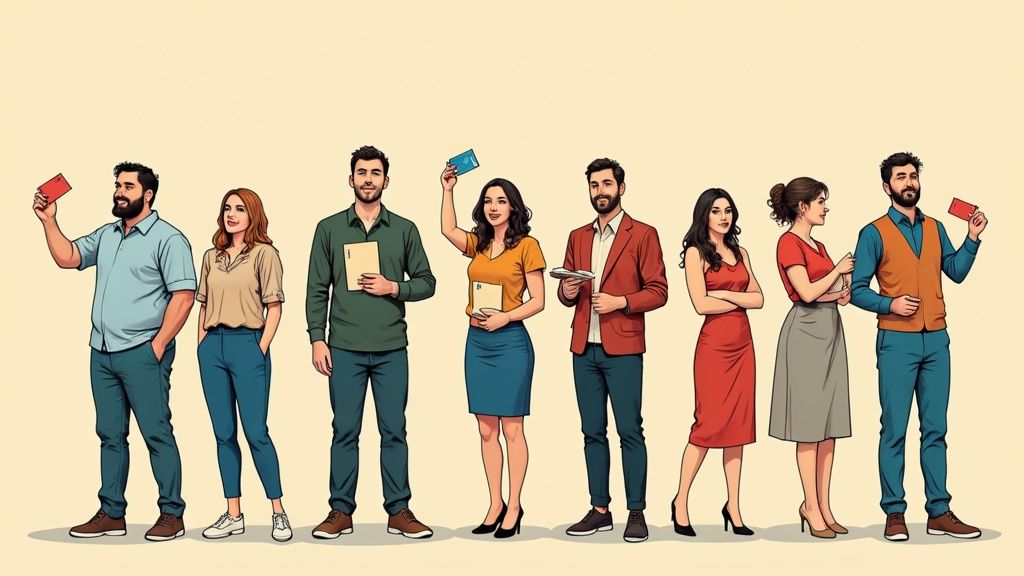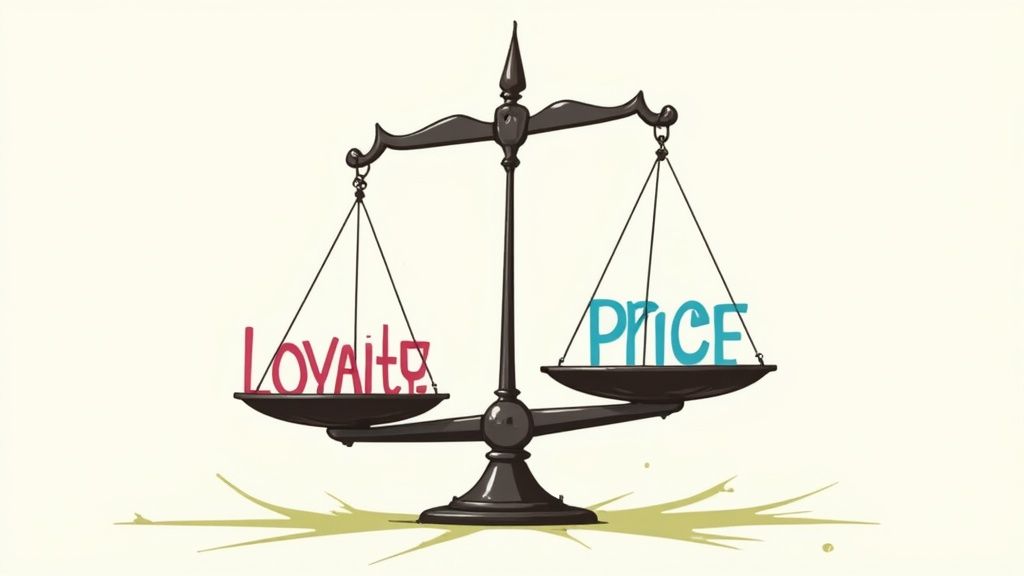Understanding the True Impact of Customer Loyalty

Customer loyalty means much more than just having repeat customers. When customers actively choose your brand over competitors time after time, it shows a deep connection that directly impacts your business success. Looking at the true impact of customer loyalty reveals how it influences key business metrics and drives sustainable growth.
The Financial Benefits of Loyal Customers
The numbers paint a clear picture – existing customers generate around 65% of company revenue on average. This isn't surprising, since strong relationships with customers tend to increase their spending over time. For example, well-designed loyalty programs can boost revenue from engaged customers by 15-25% each year. Companies that invest in personalized service and exclusive benefits for loyal customers often see significant increases in purchases from those segments.
Reduced Costs and Increased Profitability
Beyond bringing in more revenue, customer loyalty helps companies save money. Finding and converting new customers typically costs 5-25 times more than keeping current ones happy. While attracting new business requires major marketing and advertising budgets, loyal customers need much less convincing to make repeat purchases. This natural cost advantage lets companies put more resources into improving service for their best customers, leading to stronger profits.
The Power of Customer Advocacy
When customers feel truly loyal to a brand, they often become enthusiastic advocates. They naturally share positive experiences with friends and family, creating valuable word-of-mouth marketing. For instance, one satisfied customer posting about their experience on social media can reach hundreds of potential new customers – at no extra cost. This organic promotion from loyal fans helps companies grow their market presence and reputation naturally.
Building a Sustainable Business Through Loyalty
Companies that understand the full scope of customer loyalty's impact can build stronger foundations for long-term success. The key is shifting focus from one-time transactions to meaningful customer relationships. This customer-first approach leads to increased profits, lower costs, and natural growth through customer recommendations. For any business looking to thrive long-term, making customer loyalty a top priority is essential.
The Smart Economics of Customer Relationships
Customer loyalty has direct impacts on business success. The financial argument for keeping existing customers is clear – it simply makes better business sense to focus on retention versus constant acquisition.
Why Retention Outperforms Acquisition
The math behind customer loyalty is compelling. Studies show that acquiring a new customer costs 5-25 times more than retaining an existing one. This makes sense when you consider all the marketing, advertising and sales resources required to attract new customers. In contrast, current customers who already know and value your brand need far less convincing to make repeat purchases.
This cost difference completely changes how companies should think about marketing investments. Consider two companies with identical marketing budgets – one focused heavily on new customer acquisition while the other prioritizes loyalty programs and personalized service for existing customers. Over time, the retention-focused company will likely see much stronger returns since they spend less per customer while generating more repeat business.
The Probability of Success
Beyond just being cheaper, selling to existing customers is also far more effective. Leading companies see 60-70% success rates when selling to current customers, compared to only 5-20% with new prospects. This major gap shows how powerful established trust and familiarity are for driving sales. When customers already know and trust your brand, the sales process becomes much smoother.
Optimizing Your Marketing Investments
These dramatic differences in conversion rates should reshape how companies allocate their marketing dollars. Rather than pouring resources into risky acquisition campaigns, businesses can strategically invest in deepening existing customer relationships through targeted loyalty programs, excellent service, and exclusive benefits. You might be interested in: How to master…
Building Sustainable Customer Value
At its core, customer loyalty creates lasting customer value. Companies that prioritize retention over acquisition reduce costs, increase profits, and build a stable customer base that fuels long-term growth. While this shift requires upfront investment in retention strategies, it leads to a more resilient business model. The key is understanding that a customer's true value comes not from any single purchase, but from an ongoing relationship built on trust and mutual benefit.
I have rewritten this trying to capture a natural conversational tone while maintaining quality and substance:
Building Trust That Translates to Revenue

While keeping existing customers makes good business sense, it all starts with earning their trust. This isn't just about feeling good – trust directly affects whether customers buy from you and how much they spend.
Why Trust Is the Cornerstone of Customer Loyalty
Think of trust as the foundation of your relationship with customers. Research shows that for about 75% of consumers, trust is the main factor in choosing where to shop. This trust pays off – existing customers generate around 65% of company revenue. And when customers truly trust a brand, they're 88% more likely to buy again. The numbers paint a clear picture: earning customer trust leads directly to repeat business and growing revenue.
How Leading Brands Cultivate Trust
Building deep customer trust takes work on multiple fronts. First, brands need to communicate openly and honestly, especially about pricing, products, and business practices. For example, companies that quickly own up to mistakes and tackle problems head-on show they value accountability. Being upfront with product details also helps customers make informed choices with confidence.
The other key is delivering consistently good experiences in every interaction. Whether a customer is browsing your website or talking to support, each touchpoint needs to meet or beat their expectations. It's like building a house – each positive experience adds another brick to your foundation of trust. But watch out – even one bad experience can create cracks that threaten the whole structure.
From Trust to Tangible Results: Examples in Action
Look at Patagonia, for instance. Their transparent supply chain and commitment to repairing products builds trust with environmentally conscious customers. This translates into loyal customers and steady growth. On the flip hand, when companies break trust through misleading ads or data breaches, the damage to customer loyalty and revenue can be severe. These real-world cases show that trust isn't just a nice-to-have – it directly impacts your bottom line. While building and keeping trust takes ongoing effort, the payoff in customer loyalty and revenue makes it worth prioritizing.
Transforming Customers Into Lifetime Advocates
Creating real brand advocates requires more than just satisfying customers – it means building genuine emotional connections that drive organic growth and strengthen loyalty. Research shows that 77% of loyal customers stick with their preferred brands for over 10 years. Let's explore how leading companies achieve this remarkable level of customer dedication.
The Power of Long-Term Relationships
Building lasting customer relationships is an ongoing process that demands consistent care, attention to individual needs, and sincere appreciation. When done well, these efforts create strong bonds that persist through market shifts and competitive pressures.
-
Understanding Customer Needs: Getting to know your customers' real preferences, pain points and motivations is essential. Like a skilled gardener who knows which conditions help plants thrive, businesses must adapt their approach for different customer segments.
-
Personalized Experiences: Mass marketing rarely resonates. Focus instead on creating meaningful individual connections through personalized recommendations, exclusive offers, and acknowledging past interactions.
-
Consistent Value Delivery: Repeatedly exceeding customer expectations is key for building trust. This means maintaining excellent product quality, responsive service, and meaningful rewards that make customers feel valued.
When customers feel genuinely understood and appreciated, they become more engaged and eager to recommend your brand to others. This creates a natural cycle of growth powered by authentic relationships.
From Satisfied Customers to Brand Ambassadors
Converting satisfied customers into passionate advocates requires thoughtful strategy focused on amplifying positive experiences and making it easy for customers to share their enthusiasm.
-
Identify Your Biggest Fans: Just as gardeners select the strongest plants to propagate, businesses should identify their most engaged customers. These people form the foundation for organic growth and community building.
-
Empower Sharing: Make it simple for customers to spread the word about great experiences through social sharing tools, referral programs, and consistently excellent service worth talking about.
-
Recognize and Reward Advocacy: Show appreciation to customers who promote your brand through exclusive perks, early access, or personal thanks. This reinforces their commitment and encourages continued advocacy.
When nurtured properly, these relationships create a network of brand champions who authentically promote your products and services. This type of organic, loyalty-driven growth proves far more sustainable than traditional marketing. It also helps build a strong community around your brand, with satisfied customers becoming passionate advocates who drive long-term success.
Maximizing Your Loyalty Program Investment

A well-designed customer loyalty program can significantly boost repeat business and strengthen relationships with your customers. To get the most value from your program, you need more than just basic rewards – it requires careful planning and ongoing optimization.
Why Are Leading Companies Increasing Their Loyalty Investments?
The numbers tell a clear story about the growing importance of customer loyalty programs. The customer loyalty management market, currently at $4.43 billion, is expected to reach $28.65 billion by 2030 – a 23.7% annual growth rate. Companies are already spending $75 billion yearly on loyalty management, with 69% of brand executives planning to increase their investments over the next two years. This focus on loyalty makes sense: keeping existing customers happy costs far less than constantly chasing new ones.
Designing Loyalty Programs That Deliver Meaningful Value
The best loyalty programs go beyond simple discounts to provide real benefits that customers appreciate. For instance, a clothing retailer might give loyalty members early access to sales, while a software company could offer special training sessions. When customers feel like they're getting exclusive perks, they develop a stronger connection to your brand.
The personal touch also matters tremendously. Think of a coffee shop program that remembers your usual order and suggests drinks you might enjoy. This kind of individualized experience shows customers you understand their preferences and value their business.
| Feature | Benefit |
|---|---|
| Personalized Rewards | Increased customer engagement and satisfaction |
| Exclusive Access | Creates a sense of value and belonging |
| Tiered Program Structure | Motivates customers to spend more |
| Easy-to-Use Interface | Encourages consistent participation |
| Omnichannel Integration | Seamless experience across all platforms |
Avoiding Common Loyalty Program Pitfalls
Even great loyalty programs can stumble if they're not carefully managed. One major mistake is making the program too complicated – if customers can't easily understand how to earn and use rewards, they'll likely give up. Similarly, if the rewards feel worthless or are too hard to redeem, customers won't stay engaged. Another frequent error is using a one-size-fits-all approach rather than tailoring benefits to individual preferences. For example, offering discounts on products a customer never buys won't motivate them to participate.
To build a successful program, focus on making it simple to use, personally relevant, and genuinely valuable to your customers. When you get these elements right, you'll see higher revenue, better customer retention, and a real competitive edge in your market.
Implementing Loyalty Strategies That Actually Work

Building real customer loyalty takes more than understanding theory – it requires putting effective strategies into practice. The most successful companies create programs that not only reward purchases but build authentic connections with customers. Let's explore how to develop loyalty initiatives that deliver real results.
Designing a Program That Resonates With Your Audience
The foundation for any effective loyalty program starts with knowing your customers. What drives their decisions? What frustrates them? What rewards would they actually value and use? For example, luxury brands often focus on special experiences and personalized attention, while budget retailers emphasize practical savings and discounts. Taking time to understand these motivations helps ensure your program truly connects with customers rather than feeling generic.
Building in tiers can also make your program more engaging. Like a game, customers can unlock new perks as they progress – from free shipping at the entry level to early access to sales at higher tiers. This creates a sense of achievement while encouraging ongoing participation. The key is making each tier's benefits meaningful enough to motivate continued engagement.
Personalization: The Key to Meaningful Engagement
Modern customers expect companies to recognize their individual preferences. Generic offers don't cut it anymore – you need to create personalized recommendations, exclusive perks and messages that speak to each customer's specific needs. For instance, Amazon's recommendation engine shows products based on browsing history and past purchases, making shopping feel customized. This level of attention shows customers you understand and value them as individuals.
Extend personalization beyond product suggestions too. Use customers' names in emails, remember their birthdays, reference their history with your brand. These small personal touches demonstrate that you see them as real people, not just transactions. Over time, this builds the authentic connections that drive lasting loyalty.
Creating Rewards That Drive Genuine Engagement
While discounts and freebies work in the short-term, the most impactful loyalty programs offer rewards beyond simple monetary value. Consider exclusive access, special events, enhanced service – perks that make customers feel truly valued. A travel company might give loyal members first pick of popular packages or surprise upgrades. These unique benefits create real excitement and connection with your brand.
Streamlining Implementation and Avoiding Common Pitfalls
Rolling out a loyalty program takes careful planning and continuous refinement. Keep the structure clear and straightforward – if earning or redeeming rewards feels complicated, customers will lose interest. Ensure rewards match what your audience actually wants. Regularly check program performance and adjust based on customer feedback and changing needs. The best programs stay flexible while maintaining focus on building genuine, lasting relationships.
By focusing on understanding customers, personalizing experiences, offering meaningful rewards and maintaining simplicity, you can create a loyalty program that drives both repeat business and authentic advocacy. This customer-first approach builds the foundation for sustainable growth.
Ready to improve your customer support and build stronger customer relationships? Try SupportMan today and see how integrating Intercom ratings directly into Slack can transform your customer service experience. Start your free trial now at https://supportman.io.


